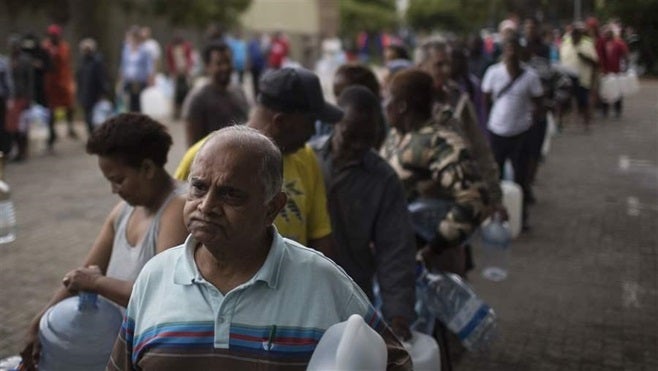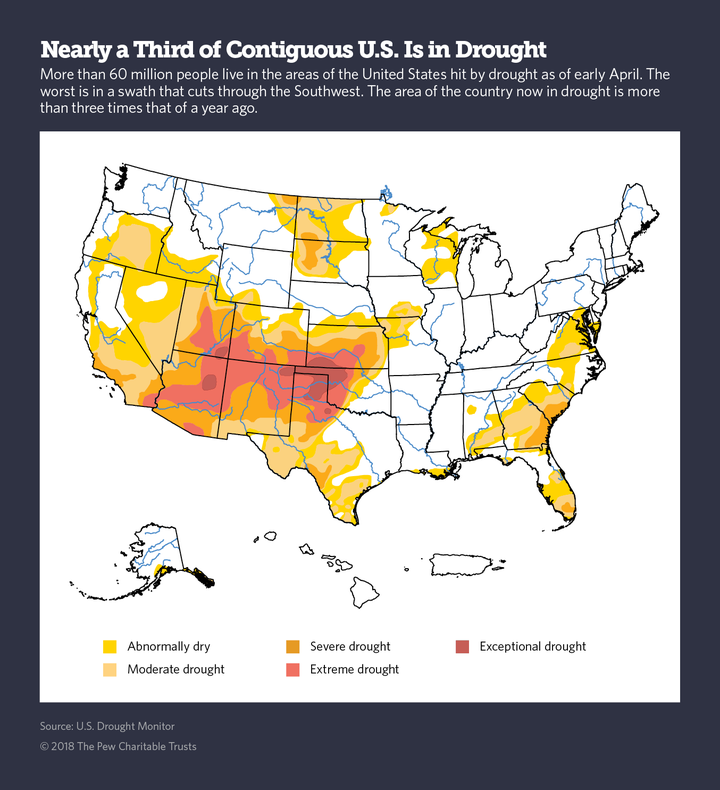Global warming, worsening droughts, vanishing groundwater and growing populations will make the U.S. more vulnerable to water shortages in the 21st century, experts say.

Residents line up in February to fill plastic water bottles and containers at a natural water spring on the site of a local brewery in Cape Town, South Africa. As a waterless Cape Town has become a potential reality, its story has sparked new concerns over the growing scarcity of the planet’s most basic resource.
By David Montgomery
AUSTIN, Texas — Less than eight months after Hurricane Harvey pelted the Texas Gulf Coast with torrential rainfall, drought has returned to Texas and other parts of the West, Southwest and Southeast, rekindling old worries for residents who dealt with earlier waves of dry spells and once again forcing state governments to reckon with how to keep the water flowing.
Nearly a third of the continental United States was in drought as of April 10, more than three times the coverage of a year ago. And the specter of a drought-ridden summer has focused renewed urgency on state and local conservation efforts, some of which would fundamentally alter Americans’ behavior in how they use water.
In California, for example, officials are considering rules to permanently ban water-wasting actions such as hosing off sidewalks and driveways, washing a vehicle with a hose that doesn’t have a shut-off valve, and irrigating ornamental turf on public street medians. The regulations, awaiting a final decision by the California State Water Resources Control Board, were in force as temporary emergency measures during part of a devastating five-year drought but were lifted in 2017 after the drought subsided.
Water restrictions, either forced or voluntary, are nothing new to states and communities where battling drought is often a part of life. In Amarillo, Texas, the city’s water department stresses conservation with the message, “every drop counts,” and urges customers to do “at least one thing a day to save water.” A similar mantra — “squeeze every drop” — is part of the water-saving culture in Oklahoma City, where officials enforce mandatory lawn-watering restrictions and impose higher rates for excessive water use.
Years of studies by government and environmental groups have warned that future demand for water is threatening to outstrip availability, particularly in the drought-plagued West and Southwest, unless policymakers take steps to reverse those trends.
“More and more cities around the world are running into limits on how much water they have available to meet their needs,” said Peter Gleick, co-founder of the Oakland-based Pacific Institute and an expert on water and climate issues.
To understand the potential dangers, U.S. officials might look halfway around the world, to parched Cape Town, South Africa, where residents this year faced a crisis that seems straight from science fiction. After three years of drought, the city of 4 million spent months united in a struggle to fend off Day Zero, when Cape Town was projected to become the world’s first major urban center to run out of water.
Residents skimped on dishwashing and laundry, took minishowers, washed their hands with sanitizer, flushed the toilet with leftover shower water, and made numerous other sacrifices to daily routines. The objective: to cut individual water consumption to 50 liters a day, or 13.2 gallons, far below the U.S. average of 80 to 100 gallons. Hundreds queued up for daily water rations as the city deployed law enforcement officers — widely dubbed “the world’s first water police” — to enforce restrictions.
The day of reckoning was originally expected to fall in mid-April, but was postponed to May and then to June.
The draconian conservation campaign had enabled Cape Town to proclaim at least partial success in March when it pushed back Day Zero to sometime in 2019. But the executive deputy mayor, Ian Neilson, said the city is still in crisis mode until it completely replenishes its water supplies.

Cape Town Scenarios in the U.S.?
The picture of a coastal metropolis going without water once seemed inconceivable. But as a waterless Cape Town has become a potential reality, its story has sparked new concerns over the growing scarcity of the planet’s most basic resource.
U.S. government and environmental experts generally agree that no major city is in imminent danger of the kind of scenario confronting Cape Town. But residents in some small communities have struggled, and at the same time, U.S. experts worry that protracted global warming, worsening droughts, vanishing groundwater and growing populations will erode future supplies and make Americans increasingly vulnerable throughout the 21st century.
One critical water resource threatened by shortages is the Colorado River System, which includes parts of seven states and provides water for up to 40 million people. In the absence of “timely action to ensure sustainability,” the U.S. Bureau of Reclamation said in a 2012 assessment of the river basin, “there exists a strong potential for significant imbalances between water supply and demand in coming decades.”
Lake Mead, a reservoir sprawling 120 miles behind the Hoover Dam in Nevada, is less than half full after years of drought. The reservoir, which is part of the Colorado River System, serves nearly 25 million people in Nevada, Arizona and California.
Burgeoning population growth is also straining water resources. The Texas Water Development Board has authorized $6.2 billion in financing for 48 municipal and regional projects after state water planners warned that the population of the second-most-populous state would grow by 70 percent over the next 50 years. Available water supplies were projected to fall by 11 percent during that same period without new investment.
The Environmental Protection Agency, in a January 2017 snapshot of the impact of climate change, predicted that the Southern Plains will face more “extreme heat” in the future, saying that the number of days of 100 degrees or hotter will quadruple by 2050.
“Increasing temperatures and more frequent and severe droughts,” the EPA said, “are expected to heighten competition for water resources for use in cities, agriculture and energy production.”
Adding to America’s water insecurity is a decadeslong decline in groundwater resources, which supply half of the nation’s residents and nearly all of its rural population, according to the U.S. Geological Survey.
Sustained groundwater pumping has steadily taken its toll on aquifers throughout the country, lowering groundwater levels by hundreds of feet in some places. Water levels in the High Plains aquifer system, which underlies parts of eight states, have dropped by more than 100 feet in places, largely as a result of extensive irrigation, according to the USGS.
“As more wells and deeper wells have been drilled to access groundwater, it exacerbates the groundwater level decline and there is often no way to get that back,” said Breton Bruce, a scientist with USGS in Denver. “Basically, we are pumping groundwater faster than it recharges.”
Large sections of the United States are all too familiar with drought and its devastating impact on both surface and groundwater. Over the past decade, Texas and California endured — and are still recovering from — record multiyear droughts that plunged lake levels, killed millions of trees, and cost billions of dollars in lost crops and livestock. Georgia went through four droughts from 1998 to 2016. Arizona has been confronting drought throughout the 21st century.
Two small communities, East Porterville in California and Spicewood Beach in Texas, drew national attention during their states’ droughts after their wells ran dry and outsiders came to the rescue with water deliveries. As many as 30 other Texas communities came close to running out of water during the drought, according to press reports.
“Things were grim. I didn’t get water for 20 months,” recalls Jim Burr, a peace justice and 33-year resident of Terlingua, a small community of about 800 people in the remote Big Bend region of Texas. After his 16-foot-deep well ran dry during the height of the last drought, Burr was forced to dig another that extended 45 feet deep.
Water Policy Is Fraught With Conflict
The latest wave of droughts has descended on more than a dozen states across the country. The largest band stretches across the Southwest and includes parts of southern California, Utah, Arizona, Colorado, New Mexico, Kansas and the panhandles of Texas and Oklahoma. Pockets of drought are also in the Northern Plains, including parts of Montana and the Dakotas, and the southeastern states of Georgia and South Carolina.
Brian A. Fuchs, associate geoscientist and climatologist at the National Drought Mitigation Center at the University of Nebraska-Lincoln, said the Southwestern drought that started in October is “the most intense significant drought area that we have going on right now.” The ultimate impact, he said, depends on how long it lasts. For now, he added, “the jury is still out.”
“It’s one of those situations where time is definitely going to tell,” he said. “If we see conditions continue to worsen over the next six months without any improvement, the situation is going to be a lot more significant than where we’re at right now.”
Most of the states on the front lines of the current drought already have spent decades shoring up their defenses, operating on a proven regimen that whenever one drought ends, another is lurking not far in the future. But at the same, the search for effective state water policy also has been fraught with conflict, often displaying the competing interests of agriculture, property owners, big cities, small communities, energy developers, conservationists and environmentalists and a host of others. Solutions never come easy.
“Water is fundamental to all the interests,” said Luke Metzger, executive director of Environment Texas, “and, at times of scarcity, it can be a feeding frenzy, where all the interests are competing for a finite supply.”
Water necessity has also led to innovation. Two Texas cities — Big Spring and Wichita Falls — have drawn accolades from environmentalists with projects to recycle waste water into potable water. In 1980, Arizona enacted what has widely been hailed as a pioneering initiative with its Groundwater Management Act, which, among other things, required new developments to prove they could assure enough water to last 100 years.
“Arizona has had a longtime history of marshaling its water forces,” said Doug MacEachern, communications administrator for the Arizona Department of Water Resources. MacEachern said the state uses less water overall today than it did in 1957 when there were at least 5 million fewer people.
California has also produced an array of water-saving initiatives, including enacting its version of a groundwater management act in 2014. The same year, Californians approved a $7.5 billion bond package on water projects that included expanding water storage, protecting rivers and lakes, bolstering groundwater sustainability and water recycling. In June, voters will be asked to spend another $4.1 billion for initiatives that include water infrastructure and flood protection projects.
“We’re running fast to try to make ourselves resilient for the long term,” said Felicia Marcus, who chairs the California State Water Resources Control Board.
In Texas, memories of destructive droughts and fears of future water shortages prompted voters in 2013 to create the State Water Implementation Fund for Texas (SWIFT) to help ensure abundant water supplies through 2070. The initiative empowered the Texas Water Development Board to authorize low-interest loans and other incentives to finance municipal and regional projects envisioned under the state’s long-range water plan.
“In general, there’s enough water for the projected future population … if we do it right,” said Janice Bezanson, executive director of the Texas Conservation Alliance. She acknowledges the potential of “case by case” shortages in small communities, but said that the state is “planning far enough in the future” to assure its cities of sufficient water resources.
The Texas plan calls for the creation of 26 new reservoirs as well as for other initiatives: recycling, an expanded push for desalination and replacing infrastructure to get rid of aging, leaking pipelines blamed for water loss. Some of the proposed new reservoirs have ignited a fierce pushback from landowners and conservationists, who say new lakes would threaten farm and ranch land, endanger wilderness areas, and encroach on wildlife habitat.
Meanwhile in Cape Town, Executive Deputy Mayor Neilson said the race against Day Zero has fundamentally redefined the city’s water strategies. Officials there, too, want to find alternatives.
The city, which doesn’t have a reliable source of groundwater, draws its supplies almost exclusively from surface water in its six major reservoirs. Neilson said officials have learned that they’ll need to diversify their water supply to other sources: groundwater where possible, along with water re-use and desalination.
And what about Day Zero? Neilson said the city is placing its hopes on good fortunes from the upcoming rainy season as well as quick steps such as building temporary desalination plants, which would eventually be followed by permanent plants.
City officials will then reassess toward the end of the year, he said.
“You start off from having years of luxury and having plentiful water,” he said. “You have certain behaviors that you develop, and you then have to teach yourself to do things differently.”

